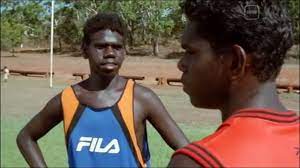Yolngu Boy: “3 lives, 1 skin, 1 dream”
- eclectic Stefan

- Jul 7, 2021
- 4 min read


Celebrate NAIDOC Week
NAIDOC Week is an Australian observance lasting from the first Sunday in July until the following Sunday. NAIDOC stands for National Aborigines and Islanders Day Observance Committee. It has its origins in the 1938 Day of Mourning, becoming a week-long event in 1975.
Due to the long-lasting nature of film imagery, Aboriginal and Torres Strait Islander people should be aware that this website may contain images, voices and names of deceased persons.
Yolngu Boy (2001)
All journeys must start somewhere and end somewhere. As if that isn’t an obvious statement to make. The difficult and challenging part tends to be the part in the middle, called "getting there".
We all make journeys and not just the long road trips your family takes during summer holidays when someone inevitably keeps asking, “Are we there yet? Are we there yet? Are we there yet?”
Journeys are often used as metaphors for the ways in which people live their lives. Metaphor and cliché would make good names for small towns we encounter along those journeys. We don’t want to go to the movies to watch people living ordinary lives. We experience enough in our own lives to want cinema experiences to take us beyond day to day living.
Although high profile films tend to dominate our film landscape, it’s the low key films that often reach to the heart of the matter.
British film gems like My Beautiful Laundrette, Local Hero, Experienced Preferred But Not Essetnial and Lock Stock and Two Smoking Barrels pick the core of some aspect of lives lived.
Australia is also capable of producing film gems. Yolngu Boy is one of those gems.
Three teenage aboriginal boys, Milika, Botj and Lorrpu, who have been friends since childhod and share common dreams, find themselves at the crossroads. Yes, it sounds like they’re standing at the crossroads of metaphor and cliché. Yolngu Boy avoids these cliches.
Milika, Botj and Lorrpu are like teenage boys anywhere. They’re influenced by contemporary music, enjoy AFL football (“Is there any other kind of football,” cries football coach Mr. ‘Obbs), show an interest in teenage girls and look to have fun times.
They are also unique teenage boys. They are aboriginal boys with common cultural links. They sum it up best, “3 lives, 1 skin, 1 dream”.


As they grow, they go down different roads. They remain friends but the bond that unites them has different strands. Now we’re at the crossroads of cliché and mixed metaphors.
Milika dreams of playing for Essendon in the AFL (“Is there any other AFL team?” cries football coach Mr. ‘Obbs again). Botj’s dream has been clouded by petrol sniffing and car theft. Lorrpu remains committed to his childhood dream and the traditions of his ancestors.
They are reunited when Botj returns from a three month excursion to jail for theft. Through misadventure, instigated by Botj, the three friends find themselves going over land and sea to reach Darwin, where Lorrpu assures them that tribal leader Dawu will lead them out of their dilemma with both white and Aboriginal laws.
Official Trailer Yolngu Boy
Yolngu Boy is filled with humour, friendship, and sadness—all the things that make up people’s lives. It is rich in nature’s imagery. It is rich in human meaning.
Images of artificial human-made structures are juxtaposed with images from nature. We are shown in subtle ways that there is a balance between human existence and our relationship wth nature and natural forces.
Yolngu Boy reaffirms that life is unpredictable, fun, sad, and filled with unexpected experiences. It also shows us that films can end in unexpected ways.
Yolngu Boy is simple in its premise yet multilayered in its presetnation of intersecting lives. Whichever road you have taken in life, don’t let Yolngu Boy pass you by.

WATCH: Yolngu Boy (2001)
Available to Buy/Rent on Apple TV+, Netflix, Ozflix TV, & Amazon.
Check availability in your region.
Australian Film Institute Awards 2001
Young Actor Award - Winner
Best Original Screenplay - Nominated
Best Cinematography - Nominated
Best Editing - Nominated
FILM EXTRAS

Rabbit Proof Fence (2002)
Three girls are torn brutally from their Aboriginal mother and sent over a thousand miles away to a training camp for domestic workers as part of a government policy to integrate them into white society. Linking the camp and their distant home territory is a vast rabbit-proof fence, which stretches from one coast to another and just might help the girls find their way back home.
WATCH: Rabbit Proof Fence
Available to stream on SBS On Demand (Free) & Stan; Buy/Rent on Apple TV+, Google Play, Prime Video & Ritz at Home.
LINK to see all available platforms to Stream/Buy/Rent:
Check availability in your region.
FURTHER READING available from AIATSIS (Australian Institute of Aboriginal and Torres Strait Islander Studies)
Disputing history, remembering country in 'The Tracker' and 'Rabbit-Proof Fence' , Felicity Collins & Therese Davis, 2006
Analysis of the films 'Rabbit-Proof Fence' and 'The Tracker', their revival of familiar figures, the lost child and the black tracker, and their role in the history wars; included in the discussion is that the role of film in the reconciliation process has been misunderstood and the stolen generations.
Acknowledgement of Country
Screen Speak acknowledges the Traditional Custodians of country throughout Australia and their connections to land, sea and community. We pay our respect to their elders past and present.








